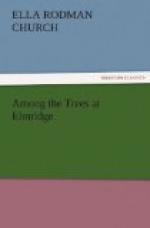“We have taken the prettiest of the spruces first,” continued Miss Harson, “and now we must see what are the differences between them. ’The two species of American spruce, the black and the white—or, as they are more commonly called, the double and the single—are distinguished from the fir and the hemlock in every stage of growth by the roughness of the bark on their branches, produced by little ridges running down from the base of each leaf, and by the disposition of the leaves, which are arranged in spirals equally on every side of the young shoots. The double is distinguished from the single spruce by the darker color of the foliage—whence its name of black spruce—by the greater thickness, in proportion to the length, of the cones, and by the looseness of its scales, which are jagged, or toothed, on the edge.’ It is a well-proportioned tree, but stiff-looking, and the dark foliage, which never seems to change, gives it a gloomy aspect. The leaves are closely arranged in spiral lines. The black spruce is never a very large tree, but the wood is light, elastic and durable, and is valuable in shipbuilding, for making ladders and for shingles. The young shoots are much in demand for making spruce-beer. The white spruce is more slender and tapering, and the bark and leaves are lighter. The root is very tough, and the Canadian Indians make threads from the fibres, with which they sew together the birch-bark for their canoes. The wood is as valuable as that of the black spruce.”
“Does the Norway spruce come from Norway?” asked Clara.
“Yes; that is its native land, where it presents its most grand and beautiful appearance. There it ’rivals the palm in stature, and even attains the height of one hundred and eighty feet. Its handsome branches spread out on every side and clothe the trunk to its base, while the summit of the tree ends in an arrow-like point. In very old trees the branches droop at the extremities, and not only rest upon the ground, but actually take root in it and grow. Thus a number of young trees are often seen clustering around the trunk of an old one.’”
“Why, that’s like the banyan tree,” said Malcolm.
“Only there is a difference in the manner of growth, for the branches of the banyan are some distance from the ground and send forth rootlets without touching it. The Norway spruce is also the great tree of the Alps, where it seems to match the majestic scenery. The timber is valuable for building; and when sawed into planks, it is called white deal, while that of the Scotch fir is red deal.
“And now,” said Miss Harson, “before we leave the firs, let us see what is said about them in the Bible. They were used for shipbuilding in the city of Tyre; for the prophet Ezekiel says, ’They have made all thy ship boards of fir trees of Senir[21],’ and it is written that ’David and all the house of Israel played before the Lord on all manner of instruments made of firwood[22].’ The same wood was used then in building houses, as you will find, Malcolm, by turning to the Song of Solomon, seventh chapter, seventeenth verse.”




